It will be the task of the court to determine if a certain case of atrocity scale environmental damage and destruction is an ecocide.
The crime of ecocide has been defined by an international panel of lawyers convened by Stop Ecocide International as:
Ecocide means unlawful or wanton acts committed with knowledge that there is a substantial likelihood of severe and either widespread or long-term damage to the environment being caused by those acts.
For the full details of the definition please visit:
https://www.stopecocide.earth/
As well as impacts in almost every nation state in the world, Ecocides are impacting on all areas of the global commons: the oceans and seas beyond territorial waters, the atmosphere, outer atmosphere, Arctic, Antarctica, cross-border rivers and lakes, ground water, migratory species, bio-geochemical cycles, and genetic heritages; crossing planetary boundaries:
https://www.stockholmresilience.org/research/planetary-boundaries/the-nine-planetary-boundaries.html
Many of these spaces and species which belong to no one, called Res nullius in law, should no longer be the scene of extreme pollution and abusive predation.
An international law of ecocide would further the protection of global ecosystems and the global commons.
The Guardian identified 10 ecocide hotspots
Below, you will find a number of examples that could potentially count as ecocide:
- Agent Orange, 1961-1971, Vietnam
- Alberta Tar Sands
- Fukushima Nuclear Disaster Debris
- Disappearance of the Aral Sea, Central Asia
- Bee colony collapse
- Oil exploitation of the Niger Delta
- Palm oil, Indonesia
- Belo Monte Dam
- Pesticides and Birds
- Hydraulic fracturing (fracking)
- Atlantic Bluefin tuna
- Great Barrier Reef under threat
- Mountaintop removal mining
- Bhopal Disaster 1984
Agent Orange, 1961-1971, Vietnam
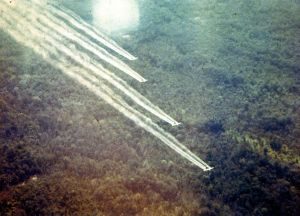
Agent Orange is the code name for a combination of two pesticides: Herbicide Orange (HO) and Agent LNX. The U.S. Military used these herbicides and defoliants as part of its chemical warfare programme ‘Operation Ranch Hand’. In 1961 and 1971, the U.S. government and the Republic of Vietnam (South Vietnam) used the ‘Rainbow herbicides’ (Agents Orange, Pink, Green, Purple, White and Blue) to defoliate forests and mangroves to clear perimeters for military use and destroy crops to starve the enemy (North Vietnam and National Liberation Front). The most known of these herbicides was Agent Orange. It was used from 1965 to 1970 and scientists estimated that about 45,677,937 litres were spread during this period.
In total, the ‘Rainbow herbicides’ represented approximately 72 million litres, meaning Agent Orange represented around 60%. Between 100,000 and 2 million hectares of land and forests were destroyed as a result from herbicide spraying during the war, and Cambodia and Laos being near Vietnam, were also affected.
Seven companies produced Agent Orange during the war. These included the multinationals Monsanto and Dow Chemicals. The South Korean supreme court assessed the correlation between the pesticide and skin diseases contracted by war veterans and ordered the two companies to pay €315,000 to indemnify the victims. Monsanto and Dow Chemicals refuted the decision and there is very little chance they will be forced to pay damages.
During its first trial in 1970, Monsanto falsified studies to ‘prove’ the absence of a link between the use of Agent Orange and the development of cancers among war veterans. Further information can be found: https://www.business-
« back
Alberta Tar Sands
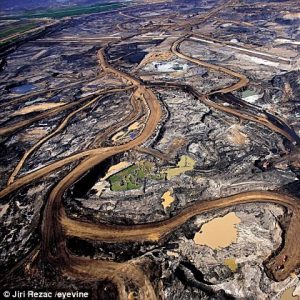
Referred to as the most damaging project on the planet, it ranks top of the list. Known as ‘dirty oil’ due to its excessively damaging outcomes, if proposed expansion proceeds, tar sand extraction will result in the loss of vast tracts of boreal forest and peat bogs of a territory the size of England. Read more at Tar Sands Network. European companies such as BP and Shell are involved and oil and tar sands extraction is financed by major European banks. For more information visit https://www.banktrack.
« back
Fukushima Nuclear Disaster Debris

Years after the 11th of March, 2011, the day the nuclear disaster in Fukushima, where the plant was struck by a tidal wave the nuclear power plant remains unsafe. An interesting study shows, that the debris will not dissolve in the pacific ocean but will stay together and drift towards the Western coast of North America. Alarming news following the disaster highlighted radiated seals in Alaska and critical exceedances of radiation in fisheries near Fukushima and of the groundwater.
Decontamination will probably last for another 30 to 40 years. How to deal with the highly radiated mud, which is produced when decontaminating more than 100.000 tons of radiated water, which are already there is unclear. The costs are currently approximated to be 1.800€ per ton of radiated water.
« back
Disappearance of the Aral Sea, Central Asia

The Aral Sea is located in Central Asia between Kazakhstan and Uzbekistan. In 1960, its surface represented 68,000 km² making it the fourth largest inland sea in the world. Today it has lost more than half of its area and three-quarters of its volume.
The Aral Sea was originally powered by two great rivers of the region: the Syr Darya and Amu Darya. These were partly diverted to irrigate vast tracts of cotton fields which led to the drying up of the sea. Indeed, from the 1960s, the Soviet Union decided to intensify the cultivation of cotton thereby expand the irrigated area of 4.5 million hectares to 7 million by 1980.
The planned removal of this inland sea has had disastrous consequences for ecology , economy, society and health. The drying up of the Aral Sea has turned the region into a vast desert. The sea, but also the lakes and marshes of the delta of both rivers also disappeared giving way to sand deserts. Therefore, the climate of the region has changed; average temperatures which ranged from 25 ° C in winter to over 35 ° C in summer, now vary between -50 ° to plus 50 °. The fauna and flora have so completely disappeared because of climate change, desertification and soil salinization. Fishing and agriculture in the region have been seriously affected leading to high unemployment. Finally, there is the social problem (difficulties accessing potable water) and health: health problems related to lack of water but also to soil pollution (over-use of fertilizers) and salinization (the soil salt levels increased due to a double effect: the disappearance of the sea and soil irrigation with a salt water).
Former Leaders of the USSR and now Russia obviously have a heavy responsibility for the tragedy of the Aral Sea and current consequences as planned intensive agriculture by deliberately destroying the ecosystem of the region. These practices have been widely criticized since the independence of the republics of central Asia by the new leaders who promised a greater attention to the environment. Thus, from 1990 to 1995, numerous regional cooperation initiatives have emerged which resulted in the signing of several agreements. However, today we see that, in fact, the situation has somewhat evolved. Economic interests have finally taken over, Kazakhstan like Uzbekistan continue the cotton culture out of fear of further degrading the social and economic situation of their country.
« back
Bee colony collapse

Since 2008 it is evident that the Pesticide Clothianidin is a beekiller. It acts on the central nervous system not only of the insects it is intended to kill but also others, such as bees. In July 2008, roughly 11,500 bee colonies were damaged and millions of bees died in southwest Germany. The seeds planted there were treated with Clothianidin to protect them from pests. Shortly afterwards the German Agency for Consumer Protection and Food Security (BVL) suspended permission to use this pesticide.
A review by the European Food Safety Authority came to the conclusion in January 2013 that neonicotinoids including clothianidin pose an unacceptably high risk to honey bees. Nonetheless, its use is still not banned throughout the whole of the EU. A 2013 study by the American Bird Conservancy claims to also have evidence that birds are dying due to corn treated with neonicotinoids: https://
« back
Oil exploitation of the Niger Delta
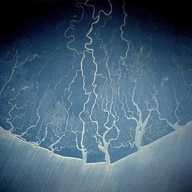
The Niger Delta, formed by the Niger River at its mouth in the Atlantic Ocean, is located in Nigeria.
30 million people live in the delta. Given the grid of pipelines and wells belonging to multinationals such as Chevron, Exxon Mobil and Total, this region is constantly polluted by oil spills. Oil extraction in the region began 50 years ago and Shell has been one of the largest operators in Nigeria. According to Amnesty International poor maintenance of oil infrastructure and the failure of some equipment have had a key role in the pollution of the delta alongside numerous human rights abuses: https://www.amnesty.
This is a serious ecological disaster, but also a drama that affects the inhabitants of the delta on a daily basis. Fishermen must now travel dozens of miles to find fish.
A Dutch court sentenced the subsidiary Shell Nigeria on January 30, 2013 to pay compensation to one of the victims who filed a case at the court for the oil spill. While the court found that the leaks were caused by sabotage related to oil thefts, it nevertheless upheld that Shell Nigeria should have intervened to prevent the alteration of its pipelines.
However, the court dismissed the remaining claims of four Nigerian farmers and fishermen who accused the parent company Shell for polluting their villages (espacially Goi and Oruma ) in the delta, ensuring that the group did not have the obligation to prevent its subsidiaries ” of doing harm to others.”
In 2021 in a landmark legal ruling in the UK communities who are seeking justice for environmental damage caused by Shell (Okpabi et al vs Royal Dutch Shell et al).
The Court found that the Ogale and Bille communities can bring their legal claims for clean-up and compensation against Royal Dutch Shell plc (RDS) and its Nigerian subsidiary, the Shell Petroleum Development Company of Nigeria (SPDC).
« back
Palm oil, Indonesia
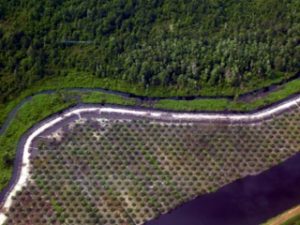
© Wakx
Palm oil is the oleaginous plant with the highest oil yield by hectare known today. For example, between 2001 and 2006, the world cumulated average yield of palm oil and palm kernel oil was 4.2 tonnes by hectare and by year against 0.4 tonnes for soya oil and 0.6 tonnes for colza oil.
Today palm oil can be found in one in ten supermarket products including margarine, baked goods, sweets, detergents and lipsticks.
Palm oil is also used for biofuel, right now the demand represents 1% of palm oil production but it is likely to increase very quickly. The main threat of palm oil plantation expansion is deforestation and the most affected countries are Indonesia and Malaysia. Their shared production represents 83% of the global production, causing “now the primary cause of permanent rainforest loss”.
For example, in Indonesia, 6 million hectares are already dedicated to palm oil production and another 4 millions will be used for biofuel only by 2015.
The conversion of tropical forests to palm oil plantations threatened life of lot of plants and animal species, among them, we find an emblematic one: the Orangutan, probably named after “orang hutan”, the indonesian word meaning “person of the forest”.
Palm oil plantations are also a climate threat with 1.8 billion tonnes of greenhouse gas emissions released each year by the degradation and burning of Indonesia’s peatlands that affects directly air pollution in neighbouring countries.
For one tonne of palm oil produced, 2.5 tonnes of effluent are generated from processing the palm oil in mills.
Palm oil plantations are not known for excessive use of pesticides and fertilizers because there is not parasite or ravager of palm oil plants, which has not a biological solution.
Even so, standard nutrients such as nitrogen, phosphorus and potassium (biogeochemicals) are applied regularly to oil palm trees causing disturbance in ecosystems and pollution of ground waters, rivers, lakes and seas and as a results ocean acidification (1).
In Indonesia, the monocrop of palm oil sector accounts for 3.7 million direct workers (2).
In 2009, among the actors dealing with palm oil, the top five palm oil producing companies are: Wilmar (Singapore/US); Sime Darby (Malaysia) (3); IOI Corps (Malaysia); Astra agro (Malaysia); KL Kepong (Malaysia) and the top five buyers are: Unilever (Netherland); Nestlé (Switzerland); Procter&Gamble (US); Cargill (US) and Kraft foods (US) (4).
« back
Belo Monte Dam

The Belo Monte Dam is a hydroelectric dam complex on the Xingu River in the state of Pará, Brazil. The building of these dams and two lakes with a combined size of 500 km² has a significant impact on the river and surrounding rainforest. The size of impact is comparable to the size of the lake Bodensee near the Austrian, Swiss and German border.
For this dam, about 20,000 – 40,000 indigenous people were relocated and an area of 1,500 square kilometers of Brazilian rainforest was destroyed. The dam is affecting hundreds of species, mostly endemic and some of them already in danger of extinction.
The Brazilian rainforest is a unique ecosystem. Such an extensive damage of a unique ecosystem on which we all depend for life can be considered ecocide.
In 2021 reports provide information on the devastating impacts on the Xingu River and the surrounding ecosystems. https://news.
European companies involved in this project as suppliers are Alstom, Andritz und Voith.
« back
Pesticides and Birds
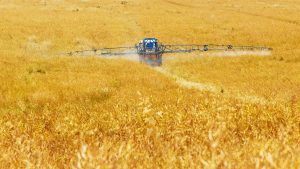
Birds play a key role in the conservation of biodiversity. Insectivores help with the struggle against some parasites and plant bugs. Birds of prey, by eating little rodents, contribute to species regulation. Scavengers prevent proliferation of diseases by cleaning up animal’s carcass before they decompose. Finally, certain birds, by carrying seeds, contribute to vegetable dispersion.Nevertheless, thousands of birds species are declining due to human activities (ecosystem destruction, hunt, pesticide poisoning). According to the IUCN (International Union for the Conservation of Nature) 13% of bird species are threatened by extinction nowadays. The book “Birds in Europe” by Birdlife International highlights the fact that on the European continent 226 species are currently considered as threatened species, or 43% of the local birds. In Europe, birds deaths by pesticide poisoning are common place, which has decimated populations for decades. Indeed, the first synthetic phytosanitary products appeared in the 1940’s and then became the basis for eradicating parasites and improving agricultural field yields. Only many years later the effects of these pesticides, and especially DDT, on birds and human beings were revealed.
The effects of DDT – which became the most widely used insecticide after World War II – on birds came to the public’s attention with the book “Silent Spring” written by the American biologist Rachel Carlson in 1962. She accuses DDT of being carcinogenic and reprotoxic (i.e. harmful for birds’ reproduction by slimming down the shell of their eggs). This pesticide was prohibited in 1972 and added to the Persistent organic pollutant ‘s list of United Nations.
Nevertheless, the use of pesticides continued. Producers were very creative in developing ever new products with severe side effects on biodiversity. Today, the most commonly used pesticides are neonicotinoids which damage our ecosystems by contaminating insects, plants, grounds and rivers.
In Europe one quarter of the birds nest in agricultural fields and an even larger number find sources of food in agricultural fields. This is why agricultural pesticide exposure is potentially significant for them (exposure happening principally with contaminated food).
However, agro-supply market leaders such as Syngenta (a Swiss company) and Bayer (a German company) producing neonicotinoids strongly oppose this legislation and lobby the European Commission to remove its proposal of restraining their use. The companies accused the report of the European Food Safety Authority to be incorrect.
« back
Hydraulic fracturing (fracking)

Hydraulic fracturing, commonly known as fracking, is a technique used to extract hydrocarbons such as natural gas and petroleum from the ground. Large reservoirs of natural gas and petroleum are stored in sandstones, limestones, dolomite rocks, shale rocks or coal beds. In order to release these resources, a fluid is injected into the ground at high pressure, so that the rock cracks and the natural gas stored inside is released. Using this technique, natural gas and petroleum stored between 1.5 and 6km beneath the earth’s surface can be accessed. Fracking has potentially severe side effects, including the contamination of ground water, air pollution, the migration of gases and hydraulic fracturing chemicals to the surface, and surface contamination from spills and flowback, all of which impact not only on our natural environment but also constitute a potential threat to human health. Scientists agree that emissions from shale gas obtained through fracking are much higher than CO2 emissions from burning standard natural gas. This is due to the potential of methane leaking during the process which is much worse for climate change than CO2. In addition, a large amount of water is needed in the process, given increasing water scarcity around the world an irresponsible waste of resources. Fracking is particularly relevant in Europe as scientists expect large amounts of natural gas to be buried in European soil which could be accessible using this technology. Several EU countries such as Bulgaria, Denmark, Germany, Poland have started investigating the options given the recent economic “success” story of shale gas in the US. The Netherlands and the UK are already practicing it. France has banned fracking.
« back
Atlantic Bluefin tuna

The popularization of the Japanese traditional sushi food in the 1970s has made the Bluefin Tuna one of the most endangered fish species in the world. Atlantic Bluefin Tuna https://www.marinebio.
Atlantic Bluefin Tuna are highly migratory fish and this makes it hard to enforce regulation. Most of the fishing occurs in the Mediterranean Sea.
A popular method is so-called farming entire Atlantic Bluefin Tuna schools are located using GPS, sonar devices and airplanes and captured in giant floating cages (see photo). These floating cages are capable of holding up to 150 tonnes of fish. They are towed to the farms where the fish are fattened until they reach the desired size and weight. The biggest importer is Japan which accounts for 90% of demand.This intense activity usually produces a large amount of organic waste in the form of excess of food, fluids and antibiotics. These sediments accumulate on the seabed beneath the farm and can cause dead zones and seriously alter the surrounding ecosystem. Furthermore, these farms also attract birds, dolphins and other predators which can get stuck in the nets.
« back
Great Barrier Reef under threat

The Great Barrier Reef has been registered as a UNESCO World Heritage Site since 1981. It is the biggest reef of the world and has sheltered 400 different species of reef, 1,500 species of fish and 4,000 species of mollusk.
The region where the Great Barrier Reef belongs, Queensland, is one of the most dynamic regions of Australia in the field of the coal and gas industries. The problem is that that alongside coral bleaching from climate change this is causing damage on the Great Barrier Reef https://www.gbrmpa.gov.
The construction of oil and gas infrastructure has put in jeopardy beaches, nesting grounds for turtles and seabirds, and mangroves, naturals habitats for marine life, birds and land based animals. According to a report from the Australian Government, mining activities could also be partly responsible for the degradation of water quality. The World Heritage Committee says “the reef will be listed as threatened ecosystem unless government takes steps to protect it.”. European banks involved in coal or gas projects in the Great Barrier Reef include BNP Paribas, Crédit Agricole, Natixis, Royal Bank of Scotland, Société générale, Commerzbank, HSBC and ING group.
« back
Mountaintop removal mining

Mountaintop removal mining (MTR) is a form of surface mining that involves the mining of the summit or summit ridge of a mountain. Entire coal seams are removed from the top of a mountain, hill or ridge by removing the land above them. The resulting debris is then piled back on the ridge to reflect the approximate original contour of the mountain. The excess amounts of land (soil, stones, flora, and fauna) that cannot be replaced on the ridge-top are moved into neighbouring valleys and streams. It is the predominant method of coal mining in the Appalachian Mountains in the eastern United States. The process involves blasting the mountain with explosives to remove up to 120 m of mountain to expose underlying coal seams. Excess rock and soil laden with toxic mining byproducts are often dumped into nearby valleys. https://www.ran.org/
« back
Ecocide in India – Bhopal 1984

The Bhopal disaster refers to a gas leak incident that occurred in India in 1984, in the region of Madhya Pradesh, 600km south of New Delhi. It resulted directly from the over exploitation of the UCIL plants (built in 1969 and 1978), a subsidiary of Union Carbide Corporation, among the biggest American chemical companies. The factory produced Temik and Sevin, two products of MIC considered extremely toxic, and that should be maintain under 0°C for safety reason (above 0°C, the liquid turns into a heavy gas). After a couple a years of underproduction due to bad economic conditions, the plants were run by a reduced team, in unsafe conditions. During one night in 1984, a succession of incidents led to the excessive pressure of a tank containing MIC, not spotted on time by operators and malfunctions in measuring instruments and safety systems. A runaway reaction started, resulting in a very high temperature inside the tank 610. The pressure broke the concrete roof, allowing about 40 metric tons of toxic gas to escape, leading to the Bhopal disaster. Right after the disaster, UCC tried to charge the Indian subsidiary UCIL for the responsibility of the accident. After several years of struggle with public authorities and the civil society, UCC came to an agreement with the Indian government in 1989, implying 470 M USD (from 370 USD to 533 USD per victim). In 1994, UCC sold UCIL, which after few transactions was taken over by the Madhya Pradesh regional government. In total denial, local authorities have been announcing that the site was not contaminated anymore, and in 2009, they even suggested to open the area for tourism. Almost 30 years after the disaster, the site remains non-decontaminated. The toxic wastes, from 4000 to 12000 tons, still stored on the site are polluting ground water and therefore, potentially continuing to poison people and ecosystems. In 2012, a project of decontamination run by the company was aborted because of ecologist association’s pressures (from Greenpeace notably) the project implying to move 347 tons of wastes to Europe, a highly risky convoy. There is no decontamination center in India able to treat properly these wastes. Dow Chemical, a leading American company that brought out UCC in 2001 would be legally now the last resort person to pursuit. A petition supported by Greenpeace has been launched recently in order to force Dow Chemical to assume its responsibility, and raise awareness on the still critical situation of the ecosystem in Bhopal (http://bhopal.net).